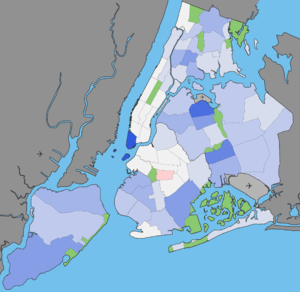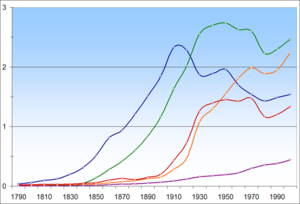- Demographics of Queens
-
Queens County
Historical Population Figures[1][2][3]Census
YearQueens
(old)Nassau
portionQueens
(new)%
increase1698 3,565 1771 10,980 1790 16,014 9,855 6,159 - 1800 16,916 10,274 6,642 7.8% 1810 19,336 11,892 7,444 12.1% 1820 21,519 13,273 8,246 10.8% 1830 22,460 13,411 9,049 9.7% 1840 30,324 15,844 14,480 60.0% 1850 36,833 18,240 18,593 28.4% 1860 57,391 24,488 32,903 77.0% 1870 73,803 28,335 45,468 38.2% 1880 90,574 34,015 56,559 24.4% 1890 128,059 41,009 87,050 53.9% 1900 152,999 75.8% 1910 284,041 85.6% 1920 469,042 65.1% 1930 1,079,129 130.1% 1940 1,297,634 20.2% 1950 1,550,849 19.5% 1960 1,809,578 16.7% 1970 1,986,473 9.8% 1980 1,891,325 -4.8% 1990 1,951,598 3.2% 2000 2,229,379 14.2% 2010 2,230,722 0.1% The demographics of Queens are one of the most diverse in the United States. No racial or ethnic group holds a majority.
Contents
General statistics
According the 2010 Census, 27.6% of the population was non-Hispanic White, 17.7% non-Hispanic Black or African American, 22.8% non-Hispanic Asian, 1.4% from some other race (non-Hispanic) and 2.5% of two or more races (non-Hispanic). 27.5% of Queens's population was of Hispanic, Latino, or Spanish origin (they may be of any race).=
According to the 2009 American Community Survey, whites made up 46.1% of Queens' population, of which 30.2% were non-Hispanic whites. Blacks made up 18.8% of Queens' population, of which 17.6% were non-Hispanic blacks. Native Americans represented 0.5% of the population. Asians represented 22.0% of the population. Multiracial individuals comprised 2.4% of the population. Hispanics or Latinos made up 26.9% of Queens' population.
As of the census of 2000, the population of Queens, New York was 2,229,379 people, 782,664 households, and 537,690 families residing in the county. The population density was 7,879.6/km² (20,409.0/mi²). There were 817,250 housing units at an average density of 2,888.5/km² (7,481.6/mi²). The racial makeup of the county was 44.08% White, 20.01% Black or African American, 0.50% Native American, 17.56% Asian, 0.06% Pacific Islander, 11.68% from other races, and 6.11% from two or more races. 24.97% of the population were Hispanic or Latino of any race. There were 782,664 households out of which 31.5% included children under the age of 18; 46.9% were married couples living together, 16.0% had a female householder with no husband present, and 31.3% were non-families. 25.6% of all households were made up of individuals and 9.7% had someone living alone who was 65 years of age or older. The average household size was 2.81 and the average family size was 3.39.
In the county the population was spread out with 22.8% under the age of 18, 9.6% from 18 to 24, 33.1% from 25 to 44, 21.7% from 45 to 64, and 12.7% who were 65 years of age or older. The median age was 35 years. For every 100 females there were 92.9 males. For every 100 females age 18 and over, there were 89.6 males.
The median income for a household in the county was $42,439, and the median income for a family was $48,608. Males had a median income of $35,576 versus $31,628 for females. The per capita income for the county was $19,222. About 11.9% of families and 14.6% of the population were below the poverty line, including 18.8% of those under age 18 and 13.0% of those age 65 or over. In 2005, the median income among black households in Queens was close to $52,000 a year, surpassing that of whites. No other county in the country with a population over 65,000 can make that claim.[4]
White population
Over 1,060,000 whites reside in Queens, of which some 697,000 are non-Hispanic whites. A significant amount of the European American population is of Italian and Irish descent. Sizable populations of Germans and Poles are also present, as well as Greeks and Russians. The White population in Queens is mainly concentrated in neighborhoods such as Astoria, Forest Hills, Glendale, Maspeth, Middle Village, Howard Beach, Bayside, Whitestone, and Belle Harbor. The top ten European ancestries are the following:
- Italian: 7.7% (178,080)
- Irish: 5.0% (115,345)
- German: 3.5% (79,917)
- Polish: 2.9% (66,718)
- Greek: 2.3% (53,342)
- Russian: 2.1% (47,842)
- English: 1.0% (23,550)
- French: 0.6% (14,913)
- Hungarian: 0.5% (10,658)
- Ukrainian: 0.4% (9,405)
Black and African American population
Blacks make up a large portion of Queens' population. According to the 2009 American Community Survey Blacks of both Hispanic and non-Hispanic origin made up 18.8% of Queens' population.[5] As of 2010, Blacks of non-Hispanic origin formed 17.7% non-Hispanic of the population. Over 434,300 blacks reside in Queens, of which some 406,000 are non-Hispanic blacks. In addition, 23,527 people identified themselves as "Sub-Saharan African" in the survey, which is equal to 1.0% of the population. Blacks are primarily concentrated in the Southeast Queens neighborhoods of South Jamaica, Springfield Gardens, Hollis, Laurelton, Cambria Heights, Locust Manor, St. Albans, Rosedale, and Far Rockaway.
Native American population
Native Americans are a very small minority in Queens. Of the borough's 2.3 million people, roughly 11,200 are Native American, which is equivalent to just 0.5% of the total population. However, people who identify as Native American with another racial group (and those who are Native American alone) make up 1.1% of the population, which is roughly 25,700 people.
Asian population
Asians have a large presence in Queens. Over one-in-five residents (22.0%) are of Asian descent. Over 506,000 Asians live in the borough. The bulk of this group are composed of people of Chinese, Indian, Korean, and Filipino descent. Asians are numerous throughout the borough but most concentrated in Northeastern and Central Queens in areas such as Flushing, Little Neck, Bayside, Fresh Meadows, Jamaica Estates, Elmhurst, Woodside, Richmond Hill, and Ozone Park. The following list provides more information on these four ethnic groups.
The 2000 census also showed that the borough is home to one of the most important concentration of Indian Americans in the nation, with a total population of 129,715 (5.79% of the borough population) ([2]. Similarly, it also has a visible presence of Bangladeshi Americans with a population of 18,310 (0.82% of the borough's population) and Pakistani Americans with a population of 15,604 ( 0.7% of the borough's population). There is also a large population of Afghan Americans, which reside predominantly in Flushing and Jackson Heights, and there is also a large portion of Arab Americans which live in Astoria concentrated in and around Steinway, with groups of Moroccan Americans, Egyptian Americans, Lebanese Americans, and Syrian Americans. The neighborhoods of Forest Hills, Queens, and Rego Park are home to a large amount of Central Asians, particularly Bukharian Jews from Uzbekistan and Tajikistan. There is also a large population of Indo-Guyanese and Indo-Trinidadian people in Richmond Hill, Queens, Ozone Park, and South Ozone Park.[3]. There are another ten Asian American groups in Queens that number over 1,000 individuals. The largest Asian American group in Queens in the year 2000 were the Chinese, numbering at 143,126 members. Those of Korean descent numbered at 63,885 in the borough. There were 33,225 people of Filipino ancestry in Queens. The borough is also home to 5,957 Japanese Americans. Those of Vietnamese, Sri Lankan, Malaysian, Indonesian, Thai, and Taiwanese descent also all numbered over 1,000, but under 5,000.[6]
Multiracial population
Multiracial individuals are a small but sizable minority group in Queens. Over 55,540 multiracial individuals reside in the borough, which is equal to 2.4% of the population. People of mixed Caucasian and black heritage number over 8,840 members and make up 0.4% of the population. People of mixed Caucasian and Native American heritage number over 4,100 members and make up 0.2% of the population. People of mixed Caucasian and Asian heritage number over 8,060 members and make up 0.3% of the population. Lastly, people of mixed black and Native American heritage number over 2,550 and make up 0.1% of the population.
Hispanic and Latino population
Hispanic and Latino Americans make up over one-quarter of Queens' population. As of 2010, 27.5% of Queens's population was of Hispanic, Latino, or Spanish origin (they may be of any race). Over 620,000 Hispanics and Latinos call the borough home. Over 123,200 Puerto Ricans (5.3% of the population) and 83,180 Mexicans (3.6% of the population) live in the borough, in addition to over 13,400 Cubans (0.6% of the population). Over 400,300 people are of other Hispanic and Latino ethnicities, such as Dominican, Salvadoran, etc. These people collectively make up 17.4% of the population. Hispanics are numerous throughout the borough but concentrated most in Central Queens neighborhoods such as Corona, Jackson Heights, Elmhurst, East Elmhurst, Woodside, Ridgewood, Woodhaven, and Ozone Park.
Source 1: [7]
Source 2: [8]
Languages
The top ten languages spoken in Queens according to the NY State Comptroller:[9]
- English
- Spanish
- Chinese
- Korean
- Italian
- Greek
- Russian
- Tagalog
- French
- Hindi
References
- ^ Greene and Harrington (1932). American Population Before the Federal Census of 1790. New York., as cited in: Rosenwaike, Ira (1972). Population History of New York City. Syracuse, N.Y.: Syracuse University Press. p. 12. ISBN 0815621558. (for 1698-1771)
- ^ "Place:Queens, New York, United States". http://www.werelate.org/wiki/Place:Queens,_New_York,_United_States#Population_History. Retrieved 2007-12-24. Forstall, Richard L. (1996). Population of the States and Counties of the United States: 1790 to 1990. Washington, DC: U.S. Bureau of the Census. ISBN 0-934213-48-8.
- ^ "Historical Census Browser 1790-1960". University of Virginia Library. http://fisher.lib.virginia.edu/collections/stats/histcensus/php/newlong.php?subject=1. Retrieved 2007-12-24.
- ^ "Black Incomes Surpass Whites in Queens." The New York Times. 1 Oct 2006.[1]
- ^ http://factfinder.census.gov/servlet/ADPTable?_bm=y&-geo_id=05000US36081&-qr_name=ACS_2009_1YR_G00_DP5&-context=adp&-ds_name=&-tree_id=309&-_lang=en&-redoLog=false&-format=
- ^ Detailed Tables - American FactFinder
- ^ http://factfinder.census.gov/servlet/ADPTable?_bm=y&-geo_id=05000US36081&-qr_name=ACS_2009_1YR_G00_DP5&-context=adp&-ds_name=&-tree_id=309&-_lang=en&-redoLog=false&-format=
- ^ http://factfinder.census.gov/servlet/ADPTable?_bm=y&-geo_id=05000US36081&-context=adp&-ds_name=ACS_2009_1YR_G00_&-tree_id=309&-_lang=en&-_caller=geoselect&-format=
- ^ How Many Languages Are Spoken in Queens, NY?
Categories:- Queens, New York City
- Demographics of New York City
Wikimedia Foundation. 2010.



